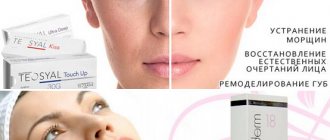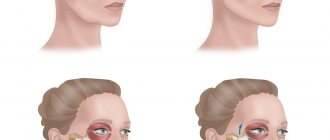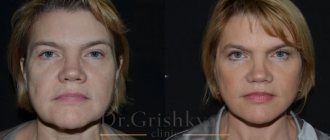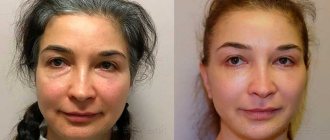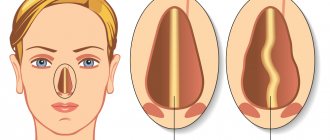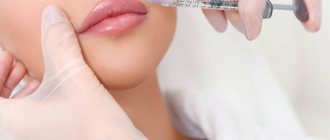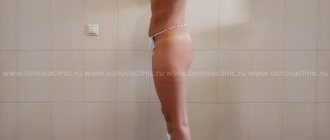There are many ways to achieve this facial contour. These are procedures to achieve desired traits. These are both cosmetic and surgical methods. However, if we talk about surgery, it is a rather painful method. After surgery, marks may remain and a long period of rehabilitation is required. You will need to stay in the hospital during the rehabilitation period and perform many manipulations in order for your face to quickly return to normal. Things are much better with cosmetology. In cosmetology, there are several ways to make cheekbones beautiful and highlight them. However, the most popular method is cheekbone contouring.
The essence of the technique
Cheek plastic surgery is a process of changing the cheekbone area and cheeks in order to give this part a more aesthetic appearance. Correction is performed in several ways: through surgery (malarplasty), injections (contour plastic with fillers), and liposculpture.
Efficiency
What effect can be achieved:
- restore facial contours;
- lifting;
- smooth out nasolabial folds;
- reduce cheeks, cheekbones;
- smooth out wrinkles;
- add volume to sunken cheeks;
- get dimples on your cheeks.
Malarplasty can change your appearance for the better, but it will not eliminate deep wrinkles. Removing Bisha's lumps will give the effect of sunken cheeks to those with a thin face. If the face is round and full, such an operation will not greatly affect its contours and the desired result will not be achieved.
Cheek plastic surgery is allowed from the age of 18. But at this age it is recommended for congenital or acquired defects on the face. If you need a lift, removal of Bisha's lumps, or plan to combat age-related changes, cosmetologists recommend doing malarplasty after 35 years, and contour plastic surgery - from 30 years. For early signs of aging, earlier correction is allowed after 25 years. But after 55 years, it is better not to resort to cheekbone surgery, as the risk of complications increases.
Attention! Age restrictions for malarplasty are not strict indicators and are advisory in nature. The decision about plastic surgery is made in each individual case.
Fillers used to correct the cheekbone
Until recently, paraffin and silicone fillers were used for this area. However, frequent cases of “side effects” (papules, displacement of the substance) prompted us to abandon the use of such substances for cosmetic purposes. Other drugs began to be used for the same purposes. Those that are then excreted from the body are usually based on hyaluronic acid. A year after the procedure, not a trace remains of it; it simply turns into carbon dioxide and water.
Artificial fillers are less expensive, but the positive results last less time. The body cannot break them down yet. So if side effects occur, you will have to make an appointment with the surgeon.
Interesting ! Not so long ago, biosynthetic fillers began to be produced. They are based on collagen or hyaluronate.
Nowadays, the question of choosing fillers that are most suitable for correcting cheekbones is quite popular. Let's talk about the most popular ones, those that are praised by the best experts.
The choice of fillers is a serious issue for those who want to improve their cheekbones
"Surgiderm"
This product, developed in France, has all the necessary certificates. The number of types of “side effects” and the risk of their occurrence are minimal. Used for a long time. The product is based on hyaluronate.
Results:
- improving skin water balance;
- filling voids;
- stimulation of collagen synthesis.
Using Surgiderm you can achieve various results
There is a large selection of products in this line, and every woman can choose a drug that is suitable for her age. It is better to do this with a specialist. The structure of “Surgiderm” is viscous, which makes it easy to model the cheekbones. The effect lasts from a year to 16 months.
Interesting ! Results need to be corrected a couple of years after the procedure.
16 months is the maximum duration of the drug
"Sculptra"
Based on artificial lactic acid. It remains in the body for 2.5 to 3 years. At the same time, the drug perfectly tightens the skin and enlarges the cheekbones. And facial expressions do not lose their naturalness.
Advantages:
- extremely low chance of side effects;
- the effect lasts up to three years;
- complete safety of the product.
Sculptra has many advantages
There is only one drawback. It consists in the need for several courses in order for the required result to appear.
Interesting ! The minimum allowable break between them is 6 weeks.
Radiesse
Another popular remedy for non-surgical cheekbone correction. It is based on calcium hydroxyapatite, the most important substance in bone tissue. Using this filler, you can tighten your face, correct the shape of your nose, and restore lost volume to your cheekbones and cheeks. Another product allows you to get rid of many age-related problems such as nasolabial folds and sagging skin.
Interesting ! The same remedy can also rejuvenate your hands.
Radiesse helps correct many defects
Once under the skin, this drug gives volume to the facial area. The result becomes visible immediately:
- smoothing wrinkles;
- correction of the shape of the nose;
- increase in cheekbones;
- improving the clarity of facial contours.
This drug can eliminate major defects in the facial area.
A couple of months pass, and the macrophages of the cells have time to absorb the entire gel. Then another component of the product comes into play - calcium microspheres. They improve the skin's production of collagen, and thanks to this, the body creates a new dermal matrix, that is, a kind of framework of cells. And thanks to this, the result of the procedure lasts for about two years.
The effect of Radiesse lasts for two years.
Radiesse does not use hyaluronic acid, but calcium hydroxyapatite, but no other product makes contouring so natural that, looking at the resulting cheekbones, you might think they are “native.” Using this product, you can absolutely clearly form the oval of the face, while, if necessary, treating both jaws.
Interesting ! With this product you can even cope with sagging lower parts, which hyaluronic acid will not help with.
Calcium hydroxyapatite ensures the effectiveness of the drug
Preparation
Since malarplasty of the cheekbones requires surgical intervention, the patient is thoroughly prepared for it in order to check the state of health, the presence of contraindications, and give several recommendations.
When visiting a plastic surgeon, the following issues are resolved:
- based on the patient’s complaints and wishes, the doctor gives recommendations on future cheekbone surgery - which technique to choose, where correction is really needed, and if surgery is not necessary, he must inform the patient about this, giving reasons for his point of view;
- the doctor finds out how psychologically the patient is ready for future changes;
- modeling of future facial contours is created using computer programs and coordinated with the patient;
- Further examination is being carried out.
What must be done:
- fluorography;
- Clinical blood and urine analysis;
- biochemical blood test;
- electrocardiogram;
- examination for infectious diseases - a conclusion is issued about the absence of HIV infection, hepatitis, sexually transmitted diseases;
- examination for blood clotting, Rh factor, group;
- coagulogram;
- visiting an anesthesiologist;
- gynecologist's report for women.
Recommendations to follow before surgery:
- 3 weeks before malarplasty, stop drinking alcohol, taking anticoagulants, oral contraceptives, and anti-inflammatory drugs;
- eating food is prohibited 6 hours before surgery;
- Half an hour before malarplasty, premedication is done - the administration of a sedative, antiallergic and narcotic painkiller in one syringe or tablets.
Kinds
To achieve the desired effect, surgical plastic surgery of the cheekbones is divided into 2 types.
Reducing
Softens facial features, making it narrower, corrects a wide jaw. To achieve this goal, different techniques are used.
Liposuction
During the procedure, fat is broken down and removed from the body. The splitting is carried out by introducing a special solution, after which the prepared fat is sucked off by vacuum. The disadvantage of this method of cheekbone correction is that it can lead to excessive sagging of the skin, so plastic surgeons recommend a more effective procedure - laser liposuction. In this case, fat deposits on the cheekbones are removed using a laser, and then with its help, subcutaneous cells are burned, provoking collagen synthesis and cellular renewal.
Thanks to laser treatment, the face becomes thinner and the skin tightens. Rehabilitation includes a two-week home regimen. It is not recommended to lose or gain weight sharply at this time.
Important! The operation requires high professionalism of the doctor, since you need to know exactly where the trigeminal and facial nerves are located. Incorrect directions of the laser beam can damage them.
Malyarplasty
The goal is to reduce the cheekbone. It is carried out by partially cutting down the bone tissue by grinding or by shifting the desired part of the cheekbone inward using reposition or osteotomy. The operation is classified as severe, occurs under general anesthesia, lasts several hours and is followed by a long rehabilitation period - up to 6 months.
Removing Bisha's lumps
This plastic surgery of the cheekbones is carried out with the aim of reducing the lower third of the face by removing special fatty formations from the cheek area - Bisha's lumps. The operation is allowed after the age of 25, since it is believed that before this time the shape of the cheekbones can change naturally and this type of plastic surgery will not be required. In addition, surgeons warn that after a few years, cheeks without lumps that fill the shape of the frame may simply “fail” and the effect of a haggard, aged face will be obtained.
Check-lifting (cheek lift)
This is done in two ways:
- superficial - during the operation, a thin layer of fatty tissue is corrected and the skin is tightened;
- deep - the muscle frame SMAS (superficial muscular aponeurotic system) is worked out. The results of this procedure are longer lasting, but if the doctor is inexperienced, there is a risk of damage to the facial nerve.
Dimpleectomy
This type of plastic surgery is used by those who want to get dimples on their cheeks. The operation is performed under local anesthesia. An incision is made through the mucous membrane on the inside of the cheek in the area where the natural cavity of the zygomatic muscle forms. The dimple itself is formed by a surgical thread, which is used to tighten the soft tissue in the area designated for the dimple. At first, such a dimple is visible even in a relaxed state, but after 1–2 months the muscles are completely restored and the dimple becomes noticeable only when smiling. Before a dimpleectomy, the surgeon warns the patient that the operation process is irreversible and it will not be possible to get rid of the dimples in the future.
Magnifying
This kind of cheekbone plastic surgery is used for the purpose of facelift, correction of the upper part of the face in places where depressions form, etc. There are several types.
Implantation
A type of malarplasty that involves the introduction of implants into the corrected part of the cheekbones in order to give them the desired shape. The implants themselves are made from materials biologically compatible with human tissue (silicone, bone tissue) and are installed for a long time. Cheekbone augmentation surgery is performed under local or general anesthesia. All interventions are carried out in two ways:
- through the mouth - an incision is made through which the implant is installed, so signs of plastic surgery will not be visible from the outside;
- the incision is made from the outside in the temple area, behind the ear, and in this case the seam will be covered with hair.
Lipofilling (liposculpture)
It includes two operations: liposuction and lipofilling. During liposuction, material is taken from the patient's own fat tissue. The resulting fat is processed and injected under the skin of the face using cannulas. The advantages of the technique are that such fillers restore the shape of the cheekbones and improve complexion. The disadvantages include the possibility of inflammatory reactions, the formation of benign cysts, and partial resorption.
After the operation, the patient needs to stay in the hospital for 1–2 days. Swelling goes away within 7–10 days. The final result is noticeable after 3 months. At this time, you can see how well the fat has been established, what part of it has resolved, etc. If necessary, additional correction of the cheekbones is done.
Types of cheekbones
In women, the cheekbone has a more pronounced and emphasized appearance than in men . This is due to the difference in the anatomical structure of the entire cranium. Each person has individual characteristics of the shape and size of the cheekbones.
The visually attractive, elevated arrangement of these symmetrical facial structures, which is more characteristic of women, is often found in men. The traditional muscular type of appearance is predominantly characterized by low, massive and flat cheekbones.
The existing varieties of large facial bones are presented in the table:
| Cheekbone type | Description and features |
| High | They are considered aesthetically flawless. Highly located cheekbones begin at the temple, smoothly bend in the area of the lower plane of the orbital socket and narrow at the lower segment - in the area adjacent to the maxillary bone. Characteristic for owners of graceful heart-shaped faces, elongated and oval types. A woman's appearance with such cheekbones is considered sculptural and does not require contouring. |
| Understated | More typical for men. They are less common in women. In girls they have a more rounded configuration. Low cheekbones originate from the earlobe and gently curve towards the corners of the lips. Such cheekbones are typical for those with round, triangular and square face types. |
| Wide | The paired bone repeats the geometric configuration of the mandibular structure of the skull. Wide cheekbones are called Mongoloid. They give a special expressiveness to the appearance and are often found on Asian top models. |
| Central location | A less common type of cheekbones. Sometimes found in girls with heart-shaped, oval and round faces. Those with centrally located cheekbones tend to develop dimples on their cheeks when they smile. |
| Little ones | The most unattractive and inexpressive option, requiring aesthetic correction. Characteristic for those with a round face. You can add more expressiveness to such cheekbones with the help of sculptural makeup. |
Owners of high cheekbones need to carefully monitor their own body weight. Excess weight makes the cheeks plump, and excessive thinness gives the appearance a sickly appearance.
How is the operation performed?
Malarplasty is performed under anesthesia:
- local - when anesthetics are injected into the site of future treatment, the patient additionally takes sedatives;
- general - accompanied by tracheal intubation. Anesthesia is administered intravenously, the patient can be connected to an oxygen supply apparatus, as well as to a monitor where the anesthesiologist monitors his condition - pressure, pulse, respiratory rate, blood oxygen saturation.
General anesthesia enhances the effect of antiseptics. The decision about what type of anesthesia to use is made by the anesthesiologist in preparation for the operation.
Types of cuts
Depending on the type of cheekbone plastic surgery, the incisions can be:
- internal - done in the mouth, in the area of the alveolar process of the upper jaw;
- external - located from the temple behind the ear, on the side where the seam is covered by hair.
Stages of the procedure
During surgery, the procedure is as follows:
- Anesthesia. Here we wait until it begins to act.
- Disinfection. The area where malarplasty will be performed is treated with an antiseptic. If incisions are made on the mucous membrane, dilators are placed in the mouth.
- Incisions are made and the cheekbones are corrected - Bisha's lumps are removed, implants are inserted, part of the tissue is excised, or a lift is done to give the desired shape. During the procedure, the first stitches may be placed.
- After this, the incision is completely sutured with surgical threads and re-treated with antiseptics.
- If it is necessary for the tissues to grow together between the resulting voids, a tight bandage is applied in this place.
The duration of the operation depends on the type, course and anesthesia used. On average, its duration is half an hour or more. The time increases if the malarplasty is complex, requires changing the shape of the bones, etc.
Attention! Any type of cheekbone plastic surgery is fraught with serious complications if performed incorrectly. Therefore, you need to resort to correction only in a proven clinic with a good reputation and choose a doctor with extensive experience and high qualifications.
Procedure
First of all, it is recommended to make an appointment with a cosmetologist, who will determine the severity of the problem. If the prolapse/ptosis is mild, fillers with hyaluronic acid or, alternatively, Radiesse will suffice.
Interesting ! If the problem is larger, it is better to use a complex of mesothreads and implants.
Depending on the problem, a suitable remedy is selected individually
How to correct cheekbones using hyaluronate?
This technique is the least dangerous way to correct cheekbones. It can be used from 20 years of age. Once in the skin, hyaluronic acid causes it to better produce elastin and collagen.
Hyaluronate is used here. It is administered with needles or a cannula. And usually it is a cannula with a rounded tip, so as not to damage the nerves and capillaries. To enlarge both cheekbones, only 1 ml of filler is required.
Interesting ! The only bad thing is that the result does not last long - only a year and a half. After this period, no trace of filler remains in the body.
How the procedure goes:
- the cosmetologist removes the remnants of cosmetics, marks the necessary areas with a marker, while avoiding areas of fat accumulation;
- applies anesthetic cream;
- waits for its action to begin (20 minutes);
You have to wait for the anesthetic to work - injects acid around the perimeter of the oval marked with a marker, inserting a needle deep into it to fill the cheekbone area;
- Forms rolls using fingers. Performs a massage so that the filler is distributed correctly;
- treats the skin with an antiseptic, and then releases the patient.
The main thing is to treat everything with an antiseptic at the end
A side effect is minor swelling, but after three days it subsides. And you can speed up the process with the help of antiseptics or anti-allergenic agents.
Attention ! Many patients do not notice any improvement after a few days, which prompts them to complain to doctors about this. But what they don’t know is that they just need to wait a little longer, allowing the hyaluronic acid to attract water molecules. The best results become noticeable two weeks after the procedure.
Use of implants
This technique is quite traumatic for the patient. The point is the need to cut the skin to insert implants. And a scar appears on the cut place. Typically, this procedure is carried out at least in the fifth decade: at this age, you already get tired of constantly injecting fillers.
Installing implants is a rather traumatic procedure.
In cases where it is only necessary to enlarge the cheekbones, the doctor makes an incision in the upper jaw.
Interesting ! But when combining this procedure with blepharoplasty, the area of the lower eyelid is cut.
The procedure is carried out as follows:
- the doctor takes photographs and x-rays to select exactly the size and shape of the implants that are required in this particular case;
- implants are manufactured. The material used is silicone or, alternatively, foamed polyethylene;
- immediately before surgery, a general anesthetic is used;
- the doctor opens the area under the cheekbone or, if he is doing a circular lift along the hairline, under the temples;
- Implants soaked for several days in an antiseptic solution are inserted through an incision;
- stitches are placed. In this case, self-absorbable material is used;
- After waiting for the patient to wake up, the doctor processes the sutures several times.
The process of installing implants is quite complicated.
The low risk of injury from the operation allows the doctor to quickly release the patient from the clinic. The stitches may remain swollen for some time and swell a little. At home they should be treated with antiseptics.
At first, discomfort in the form of sensations of a foreign body cannot be ruled out. But just a few weeks are enough for the implant to stop causing discomfort and for the face to begin to look natural.
Interesting ! There is no need to correct the result.
At first you will feel a lot of discomfort
Lipofilling
The technique is minimally invasive. During this procedure, the patient's fat is injected into the cheekbone area. All this is done in several stages.
The procedure looks like this:
- a drug for local anesthesia is injected into the stomach or thighs;
- a longitudinal incision is made in the desired area, a little fat is removed, and a suture is applied;
- the fat is cleaned of blood and anesthetic using special equipment to obtain pure material;
- the anesthetic is injected into the cheekbones;
- Fat is injected under the treated area using a thin cannula;
- The doctor treats the punctured areas with an antiseptic.
The procedure is not too complicated, but effective
The main disadvantage here is the reabsorption of adipose tissue. This means that about a third of the injected fat will be absorbed within 90 days. So the doctor injects it “with a reserve” during the procedure.
Interesting ! Also, fat often forms lumps, which spoils the appearance.
Fillers
This method involves the use of special substances to fill the cheekbones. Hyaluronic acid and calcium hydroxyapatite are used here. The latter remedy is more common than the others, since it takes root well and is poorly reabsorbed. Its other advantages are long resorption and the absence of the ability to form lumps. Calcium hydroxyapatite is obtained from seaweed and corals.
Interesting ! Due to the fact that this substance is also in the bones, it is not rejected by the body.
The use of fillers is quite popular today.
Procedure:
- examination of the face by a doctor, removal of makeup;
- dividing the cheeks into zones, drawing ovals for injecting filler;
- using a local anesthetic and waiting for its action to begin;
- injection of filler using a round cannula along the markings;
- massage to ensure that the gel is distributed evenly;
- treatment with an antiseptic, after which the patient can go home.
Calcium hydroxyapatite is not rejected by the body
Usually people tolerate the procedure well. Edema and swelling are very rare. The use of a cannula completely eliminates the occurrence of bruises: its rounded end does not tear tissues and blood vessels, but pushes them apart.
Interesting ! A filler based on calcium hydroxyapatite stays in the body for a couple of years.
The effect of fillers lasts quite a long time
Photos before and after
Rehabilitation period
Immediately after cheekbone surgery, a rehabilitation period begins. At this time, the face swells, the patient feels a burning sensation, skin tightness due to swelling, pain, and discomfort. The hardest days are the first three days. The rehabilitation period can last up to six months. It all depends on the complexity of the operation. The hardest thing to recover from is surgery on bone tissue.
Peculiarities:
- at first you need to stay in a hospital, after discharge - under the supervision of loved ones;
- after malarplasty, a course of antibiotics is prescribed for 3–5 days;
- During the first 3–4 days, severe pain persists, so taking painkillers is allowed;
- sutures in the mouth heal quickly - within 3-4 days, but swelling persists longer - from two weeks to 3 months;
- during intraoral intervention, you should rinse your mouth with an antiseptic solution several times a day for 4–5 weeks;
- external sutures are processed according to the surgeon’s recommendations;
- to speed up the process of disappearance of edema, decongestant and anti-inflammatory drugs can be prescribed, most often Traumeel S;
- until the swelling disappears, it is recommended to sleep on a high pillow, avoiding a face-down position;
- Hardware procedures—microcurrents—can also be prescribed to speed up healing.
On average, the result after cheek surgery lasts about 10 years. Correction of cheekbones, removal of Bisha's lumps, dimplectomy remain unchanged throughout life.
Scars do not completely dissolve, but they are almost invisible and do not cause any discomfort.
Facial care after cheekbone contouring
- Do not apply makeup to your face for 12 hours after contouring. After the procedure, you should not apply facial care; on this day, use only Traumeel S.
- After contouring, you should not wash your face with hot or cold running water. For a week or even two, avoid hot baths and showers.
- During the 2nd week of the procedure, it is prohibited to carry out any active cosmetic procedures until sensitivity is restored at the cannula entry points.
- For 2 weeks after contouring, it is forbidden to be in direct sunlight, visit the solarium, as well as bathhouses and saunas.
- You should not engage in sports for 2-3 days after the procedure.
- The doctor may prescribe painkillers (Nimesil or Dexalgina), as well as local application of Traumeel S, Lyoton or Bruise off. This will quickly eliminate swelling, hematomas and bruises, as well as relieve inflammation.
The price of my contour plastic surgery at ANA-Cosmo: 9500 UAH.
Where is it made and cost?
Malarplasty and contour plastic surgery of the cheekbones are done in special clinics with permission to carry out such interventions. It is better to consult a doctor with experience, who is well versed in the nuances of the procedure, knows the structure of the face, the location of nerves and blood vessels.
The cost of surgical plastic surgery of the cheekbones depends on the complexity of the intervention. The starting price is about 65,000 rubles. Bish's lumps can be removed at a cost of about 35,000 rubles. The price for a dimpleectomy is approximately the same.
Restrictions after surgery
To avoid complications you should:
- at first, eat liquid and viscous foods - cereals, jelly, soups, etc., avoiding solid foods;
- after surgery, you should not eat hot, spicy or sour foods through the mucous membrane until the incisions are completely healed;
- For the first month, it is advisable to give up smoking and drinking alcohol - bad habits slow down the healing process;
- For the same period, visiting solariums, baths, playing sports, and excessive facial expressions are prohibited.
What complications can there be?
Depends on the type of correction.
Side effects after surgical cheekbone surgery are divided into 2 types:
- are common;
- specific.
General complications
Appear during any surgical intervention. These include:
- swelling;
- nausea;
- pain;
- bruises;
- numbness;
- scars at the site of sutures;
- dizziness;
- bleeding;
- allergy;
- inflammation.
Specific
They appear after malarplasty due to violations of the rules of the rehabilitation period, characteristics of the body, or due to the inexperience of the doctor.
It can be:
- infectious phenomena;
- implant rejection;
- facial asymmetry;
- pigmentation;
- chronic sinusitis;
- displacement of the zygomatic bones;
- paralysis of part of the face if the facial nerve is affected;
- incomplete functioning of the jaw area;
- tissue necrosis;
- sagging skin.
Complications can occur throughout the rehabilitation period, so until its completion it is important to be under constant supervision of the surgeon.
When is revision surgery required?
Repeated (revision) malarplasty is indicated if the following phenomena are observed after surgery:
- asymmetry;
- there were no changes due to cheekbone surgery;
- sagging skin;
- implant migration, its instability;
- additional correction is needed.
Side effects and complications
After the procedure, 9 out of 10 patients experience significant side effects that cause discomfort. Fortunately, such phenomena are short-lived and rarely last longer than 2 to 4 days. They manifest themselves in swelling, bruising and redness of the skin. Patients often feel pain, discomfort, and itching. In rare cases, a rash appears on the skin, indicating an allergy.
When bacteria enter the injection sites, inflammation can begin, which is why it is so important to carry out regular antiseptic treatments. For bruises, cold compresses are recommended; for swelling, reducing water intake. Allergic manifestations must be stopped with antihistamines.
If side effects persist for more than a week, repeated consultation with a specialist and examination is required. Paying close attention to your health will help you prevent the development of serious complications, such as fibrosis.
Contraindications
Plastic surgery cannot be performed if the patient:
- infectious diseases of various origins;
- exacerbation of chronic diseases;
- allergic manifestations;
- disruption of the cardiovascular, nervous, endocrine and respiratory systems, including diabetes and hypertension;
- oncological diseases;
- metabolic disorder;
- blood diseases and clotting problems;
- skin irritation, rash at the correction site;
- pregnancy, lactation.
Alternative Methods
Other techniques are also used to correct cheekbones.
Contour plastic surgery - use of fillers
During the procedure, gel-like fillers are injected into the areas where volume needs to be added. Most often, fillers based on hyaluronic acid and calcium hydroxyapatite are used for this.
The procedure does not last long - from 15 minutes to an hour. The duration depends on the location of the problem area, as well as whether anesthesia was used during the session or not. Advantages of cheekbone contouring:
- speed of the procedure;
- short and easy rehabilitation period;
- Over time, fillers dissolve;
- it is possible to neutralize hyaluronic acid in case of side effects.
The disadvantages of the method include the fact that the result lasts from 6 months to 3 years, then cheekbone plastic surgery with fillers is carried out again to maintain the effect.
Hardware therapy
It involves the effect of special radiation on the skin of the face:
- laser - the beam penetrates the subcutaneous tissues, injures them and stimulates the production of collagen, as a result of which the skin is rejuvenated, the contours of the cheekbones become more defined;
- radio frequency (RF-lifting) - during the procedure, the subcutaneous tissues are heated, as a result of which the collagen fibers contract and the facial muscles are tightened.
Cryolifting is also used - exposure of the dermis to extra-low temperatures (-20 degrees Celsius). This technique stimulates collagen production, strengthens blood vessels, relieves swelling, and removes toxins.
To achieve results, hardware cosmetology must be carried out in a course of at least 3 procedures. It is worth noting that such techniques can only rejuvenate and tighten the skin; dramatic changes in appearance do not occur after them.
Mesothreads
Thanks to this correction of the cheekbones, the facial frame is formed by introducing special cosmetic threads. Mesothreads are inserted using long needles with a blunt tip - a cannula. The effect lasts up to 2 years.
Plasmolifting
During the procedure, the patient's processed plasma is injected under the skin. The technique has a rejuvenating effect, improves metabolic processes, smoothes wrinkles, and promotes cell regeneration.
Gymnastics (face building)
An effective technique for strengthening facial muscles, shaping the contour, and preventing aging. To achieve results, you need to do special regular exercises for a long time.
Reasons for prescribing injections
It’s hard to disagree with the fact that a woman’s face with prominent, raised cheekbones looks much younger and more expressive than with a different shape. If for some reason the situation is not like this, it can be easily corrected by contacting a cosmetologist for correction using one of the well-known techniques, the simplest of which is changing the shape of the cheekbones using fillers.
Reference. Filler is an English word, the translation of which is filler. Fillers are special viscous gel-like injectable preparations used as fillers to correct cosmetic defects of the face and body associated with minor tissue deficiencies.
Correction of cheekbones with fillers is a contouring procedure, which consists of introducing special preparations based on hyaluronic or poly-L-lactic acid, calcium hydroxyapatite and others under the cheekbones using a thin needle. Since such substances are contained in the human body, they are not rejected. Fillers injected under the cheekbone and into the temporal area fill voids in the skin tissues and increase the volume of the cheekbones.
Reasons why patients are given injections include:
- Age-related changes associated with loss of elasticity of the epidermis (ptosis) and the appearance of fatty deposits:
- sagging and sagging skin on the chin;
- hollow cheeks;
- wrinkles on the lower eyelids;
- loss of a clear facial contour due to the appearance of jowls (downward swelling of the cheeks) to the right and left of the chin;
- thinning of the dermis;
- the appearance of nasolabial folds.
- Facial asymmetry as a result of cranial injuries or paralysis.
- The corners of the lips are downturned, which gives the face a sad expression.
- Insufficient expression of the cheekbones due to the natural structure of the facial part of the skull.
- Incorrect development of the cranium.
Experts' opinion
The expert in this review says that there are no age restrictions for plastic surgery of the cheekbones. But he emphasizes that after 70 years of age this type of surgical intervention is not recommended.
The popular operation to remove Bisha's lumps is not always indicated. The surgeon speaks about this when answering a question from a patient who wants to remove sagging cheeks.
The doctor from this review also warns about possible consequences after removing the lumps. The surgeon says that they support the muscles, and if before the age of 35 the operation gives the effect of a refined face, then after this age the muscle tissue relaxes, and the face looks haggard and tired. And then contour plastic surgery is needed - correction of the cheekbones with fillers. He also talks about lipofilling, warning that the injected fat can have side effects - inflammation and seroma.
Side effects from the procedure with injections into the cheekbones
It happens that correcting the cheekbone model with filler is not crowned with success. According to patient reviews, this happens due to the fault of an unqualified specialist or due to ignoring compliance with post-procedure instructions.
As a result, swelling, redness, and bruising occur in the area where the drug was administered. Small formations disappear on their own after a couple of days.
Fortunately, dangerous deteriorations after the administration of injectable doses of the gel occur rarely. But it’s worth knowing about them and not ignoring them if they arise:
- feeling of pain in the cheek area;
- inflammation;
- thickening;
- blockage of blood vessels.
Even the slightest disturbances in the cheekbone area after filler injections should not be neglected. The doctor who performed the procedure will help you understand what is happening and not miss the dangerous symptoms of side effects.
Patient reviews
The girl in this review talks about her well-being and the condition of her face a month after malarplasty. He says that there is some swelling left and sensitivity has not fully returned.
Detailed details of the girl’s rehabilitation period are here https://plastic-surgeon.ru/forum/showthread.php?t=14371
The patient shares her experience of removing Bisha's lumps in the following review. He says that even after 2 months he does not see the final result, as swelling is noticeable. According to the surgeon, the effect will only appear in 4–6 months.
The following patient talks about the sensations during the operation to remove Bisha’s lumps. He notes that the pain was tolerable, but it intensified slightly at the time of removal of fat pieces. The girl also says that the lumps themselves are also removed in different ways: on the one hand, it came out easily, but on the other hand, the surgeon had to tinker with it to remove it. Attached is a photo of the lumps themselves.
Details here https://irecommend.ru/content/foto-ne-dlya-slabonervnykh-o-tom-kak-prokhodit-plasticheskaya-operatsiya-i-posleoperatsionny
The patient in the following review felt well after the operation. She says that she immediately saw how her cheeks became smaller. But then severe pain appeared and I had to take painkillers. The next day there was severe swelling and the doctor prescribed Traumeel - ointment and tablets at the same time.
The patient was dissatisfied with the outcome of the operation to remove Bisha's lumps, she waited 2 months for the result and did not receive it. He believes that there is no effect from the operation.
Cheek surgery is a serious intervention that can change your appearance for the better. But in order for the result to turn out as desired, and after the operation not to become a victim of serious complications, you need to put your face in the hands of a highly qualified doctor who values his reputation, strives to do his job perfectly and is able to direct the patient’s desires in the right direction. After all, a person’s opinion about his appearance is not always correct, and an experienced surgeon will be able to point this out and offer an option that will be for the benefit of the client himself.
